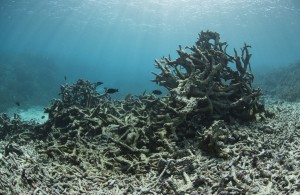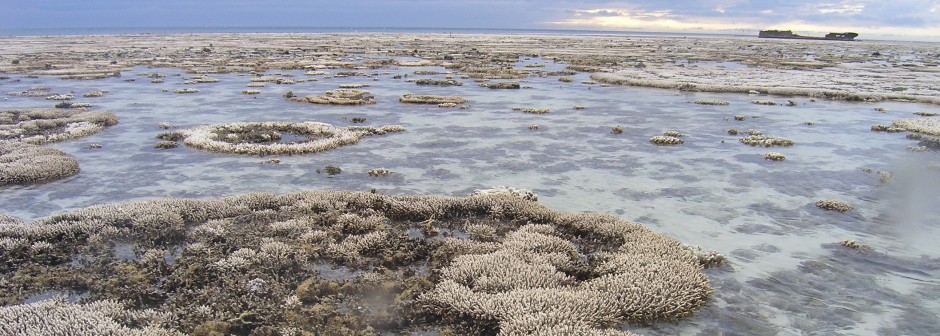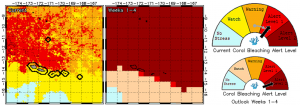Coral reefs in American Samoa had a tough year in 2015. That year, bleaching due to high water temperatures led to widespread death of corals, reaching 80% on some reefs [1]. Reefs in the region experienced bleaching-inducing temperatures all the way from January to June, with the worst stress taking place from late February to the end of April. From mid March to late April, stressed exceeded eight degree heating weeks (DHW), with a peak of eleven DHW at the end of March [2]. The bleaching itself was observed as early as February [1].
 Bleaching in 2015 led to the deaths of many corals on American Samoan Reefs, such as the one seen here. From http://www.globalcoralbleaching.org/
Bleaching in 2015 led to the deaths of many corals on American Samoan Reefs, such as the one seen here. From http://www.globalcoralbleaching.org/
This year, temperature stress has been much milder. Though we are yet to see what will happen when temperatures are at their worst in late April, 2016 had a much milder February and March compared to the year before [2]. While the intensity may be less and the buildup certainly slower, the worst is still yet to come. The Samoas are already in Alert Level 1, according to NOAA’s Coral Reef Watch, and the entire region is expected to be under Alert Level 2 for the next month, after which the high temperatures will subside, save for the area north of the islands, where Pukapuka and Tokelau will experience critical bleaching stress for the next few months [2]. Whether or not we get a repeat of the mass death seen in 2015 is still up in the air.
Data from NOAA’s Coral Reef Watch indicates the next several weeks will be the worst for the Samoan region. From http://coralreefwatch.noaa.gov/vs/gauges/samoas.php
Another factor at play, other than the lower sea temperatures compared to last year, is the resiliency of the corals themselves. A 2014 study found that Acropora hyacinthus on the reefs of Ofu in American Samoa showed that the coral was employing roughly equal parts genetic adaptation and physiological acclimatization to deal with increased temperatures [3]. Whether or not this is enough to significantly stave off future bleaching events, or if other corals are as resilient, is still unknown [4].
1.) Global Coral Bleaching. Underwater Earth, 2015. Web. <http://www.globalcoralbleaching.org/>.
2.) “Samoas 5-km Bleaching Thermal Stress Gauges.” NOAA Coral Reef Watch. US Department of Commerce, 16 Apr. 2016. <http://coralreefwatch.noaa.gov/vs/gauges/samoas.php>.
3.) Mascarelli, Amanda. “Corals Use Multiple Tricks to Adapt to Hotter Seas.”Nature.com. Nature Publishing Group, 24 Apr. 2014. Web. <http://www.nature.com/news/corals-use-multiple-tricks-to-adapt-to-hotter-seas-1.15104>.
4.) Palumbi, Stephen R., Daniel J. Barshis, Nikki Taylor-Knowles, and Rachael A. Bay. “Mechanisms of Reef Coral Resistance to Future Climate Change.”Science 344.6186 (2014): 895-98. Sciencemag.org. American Association for the Advancement of Science, 23 May 2014. Web. <http://science.sciencemag.org/content/344/6186/895>.


